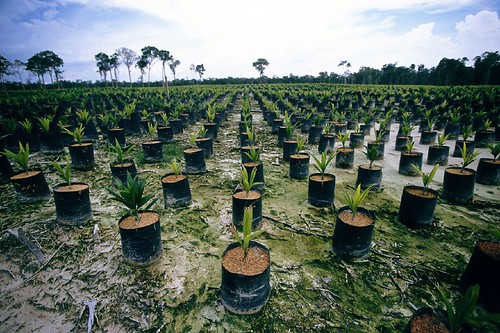 As our exceedingly large population continues on its exponential path and our finite resources are being consumed, the need for renewable resources bears greater weight. Unfortunately, with an increased pressure on agency officials and corporate heads comes a dangerous tendency to settle on a quick-fix. One such situation is the proposed ‘solution’ to be found in biofuels.
As our exceedingly large population continues on its exponential path and our finite resources are being consumed, the need for renewable resources bears greater weight. Unfortunately, with an increased pressure on agency officials and corporate heads comes a dangerous tendency to settle on a quick-fix. One such situation is the proposed ‘solution’ to be found in biofuels.While biofuels have been shown to burn cleaner, emit less particulates, and cost significantly less than imported oil, the environmental costs are often overlooked. Palm oil, the “world’s leading vegetable oil,” has quickly gained popularity as a biofuel; in 2010, the “largest biofuel plant in the world,” an oil palm plantation/refinery, was established (Wikipedia, Palm Oil). The growth of oil palm plantations, however, has a direct correlation with the destruction of tropical rainforests. With “more than 50,000-sqare miles of moist, tropical lowland areas” already occupied by oil palms, deforestation via plantation development has been deemed one of the “biggest ecological impact[s]” on diminishing
 biodiversity. Where oil palms have replaced rich forests, less than a sixth of the species found in primary forests are present. One of the biggest victims of this habitat destruction is the Orangutan, who is now identified as "critically endangered" by the IUCN. What’s worse is that “degraded forests, and even alternative crops…supported higher numbers of species” than the oil palm.
biodiversity. Where oil palms have replaced rich forests, less than a sixth of the species found in primary forests are present. One of the biggest victims of this habitat destruction is the Orangutan, who is now identified as "critically endangered" by the IUCN. What’s worse is that “degraded forests, and even alternative crops…supported higher numbers of species” than the oil palm.Unfortunately, demand for biofuel is “increasing rapidly”—more rapidly than we are addressing the issue. In the case of wildlife, it seems that there is little to be done for those already within the plantations, so the best strategy is to simply avoid the proliferation of plantations onto valuable, rich land. However, in finding new places for these plantations to reside, one must consider the “careful distinction between degraded land that is of low conservation value…and partially logged or degraded forest areas which can still harbor relatively high levels of biodiversity.” In any case, it seems as though we need to approach ‘solutions’ with greater caution and thoroughly asses the pros and cons of any alternative before jumping on the ephemeral bandwagon.
Fitzherbert, Emily et al. "How will oil palm expansion affect biodiversity?" Trends in Ecology and Evolution
23.10 (2008): 538-545. ScienceDirect. <http://www.sciencedirect.com/science/article/pii/S0169534708002528>
"Oil palm plantations are no substitute for tropical rainforests." PHYSORG. N.p., 15 Sept. 2008.
<http://www.physorg.com/news140693440.html>
Photos:
http://www.designsigh.com/2009/04/borneo/
http://www.commercialpressuresonland.org/press/palm-oil-land-grab
http://www.flickr.com/groups/35468158660@N01/discuss/93944/

No comments:
Post a Comment